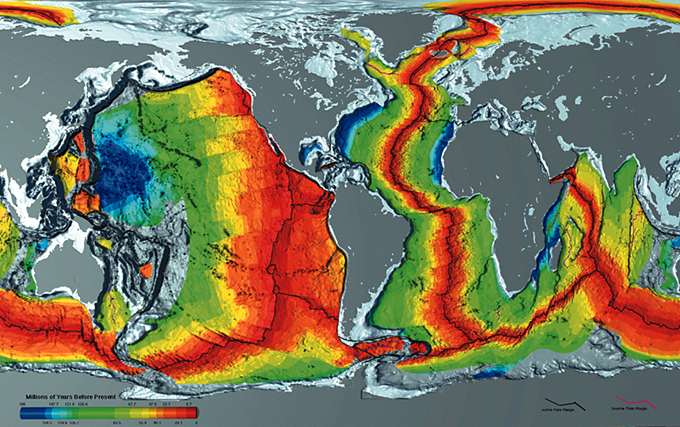
Take a guess: what’s the longest mountain range in the world?
The Rockies? At 3,000 miles, they traverse the U.S., Canada, and Mexico. But they’re not even close.
How about the Andes? Nope. They stretch most of the length of South America, but that’s just 4,000 miles.
The longest range in the world is over 40,000 miles long. Yes, one and a half times the circumference of the globe itself! How could that be?
Well, this range zig-zags across Earth like the stitch lines on a baseball, but there’s only one place you can easily see it: in Iceland. Everywhere else, it’s underwater.
That’s right, this mountain range follows the tectonic plate boundaries between continents, under the ocean. This chain, called the mid-ocean ridge, is created as the plates spread apart, when molten mantle pushes up to fill in the opening space. At these points you can see the ocean floor forming. Provided, that is, you have a deep-sea submersible.
At times the top of the ridge is a mile underwater. But because the ocean around it might be more than 2 miles deep, that means these mountains are still a mile high!
If you didn’t already know about this, don’t feel too bad. It wasn’t until the 1950’s that scientists had the technology to notice the largest continuous geologic feature on Earth.
Background
Synopsis: The longest mountain range on Earth wasn’t discovered until the 1950’s, hidden from us beneath the oceans until finally revealed by technology. The processes that created the range renew the surface of and drive the dramatic tectonic forces that characterize our dynamic planet.
- The longest mountain range on Earth isn’t the Rockies, more than 3000 miles long, or the Andes, 4300 miles long.
- The mid-ocean ridge has them both beat—it is more than 40,350 miles long!
- As its name suggests, about 90 percent of the mid-ocean-ridge system lies under the ocean.
- This largest single volcanic feature on Earth is made up of thousands of individual volcanoes or volcanic ridge segments.
- The movement of Earth’s crustal plates creates the mid-ocean-ridge system as ductility in the underlying mantle enables these great plates to shift in response to tectonic forces.
- Where the plates pull apart, magma rises to fill the gaps, creating mountains and valleys of new ocean floor, a process that literally renews the surface of our planet.
- This system of mountains and valleys runs throughout the world oceans like the stitching on a baseball. Its crest averages -7500 ft below sea level, but it dives to -12,000 ft in the Cayman Trough and rises above sea level in Iceland. These amazing changes in elevation are related to differences in the heat of the mantle below the system.
- The width of the range is related to the speed of spreading. Slow-spreading ridges like the Mid-Atlantic Ridge have rugged terrain at the crest, with more than 3000 ft of relief; fast-spreading ridges like the East Pacific Rise have narrow, sharp incisions surrounded by generally flat topography that slopes away from the ridge over many hundreds of miles.

